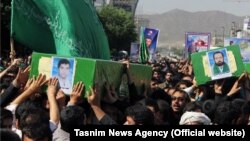Iran has sent thousands of Afghan Shi'a to the battlefields of Syria, catapulting them to the front lines of President Bashar al-Assad and his allies' brutal six-year war against armed rebels, some of them foreign-backed, and Islamist extremists.
As the first line of attack, the poorly trained proxy force made up of mainly Afghan migrants and refugees known as the Fatemiyoun Division has suffered a high rate of attrition, observers say, with coffins of fallen soldiers paraded and buried in Iranian cities almost every week.
To foster morale and lure new recruits to Fatemiyoun, Tehran is seeking to burnish the image of the beleaguered group -- comprising mainly Afghan refugees from the Hazara Shi'ite minority recruited and trained by Iran's powerful Islamic Revolutionary Guards Corps (IRGC).
Iranian authorities have renamed streets to honor the Afghan Shi'ite fighters, state media have glorified fallen fighters and highlighted their sacrifices while likening them to martyrs, and the group is frequently visited by General Qassem Soleimani, the influential, media-savvy head of the IRGC's elite Quds Force, which is responsible for operations outside of Iran's own borders.
Footage aired by Qatar-based television network Al-Jazeera in June showed footage of Soleimani, who is overseeing Iran's war effort in Syria, praying and addressing the Afghan fighters near the Syria-Iraq border.
Iranian state media reported recently that the Lebanese militant group Hizballah was training Afghan "special forces" in sniper skills, "night-vision mounted weapons," and surveillance. Hundreds of trainees were said to have been deployed across Syria.
The IRGC published photos of the training in June.
"In reality, there is absolutely no hard evidence of [the] existence of such skills among the Fatemiyoun fighters," Ali Alfoneh, a nonresident senior fellow at The Atlantic Council in Washington and a leading IRGC expert, told RFE/RL. "This is a myth carefully nurtured by the IRGC to boost the prestige of the brigade."
'Cannon Fodder'
Iranian authorities quietly began deploying armed volunteers, including many Afghans, to complement other Iranian forces advising and fighting alongside Assad's troops after civil war broke out in Syria in 2011.
Iran has recruited thousands of Afghan migrants and refugees within its own borders. There is also evidence of Tehran covertly recruiting hundreds of Afghan Shi'a inside Afghanistan. Afghanistan is majority Sunni, but 15 percent of its population, mainly Hazaras, are Shi'ite with religious links to Shi'ite-majority Iran.
The United Nations estimates the number of Afghan citizens in Iran at just under 1 million, but Tehran puts the figure closer to 3 million. Tehran has expelled many Afghans and periodically threatens those who remain -- and Kabul, which is battling Afghanistan's own insurgents -- with mass expulsions.
Iranian authorities say the fighters travel to Syria and Iraq voluntarily to defend holy Shi'ite sites. Some reports suggest Afghans are offered financial reward and Iranian residency permits to join the fight in Syria.
Alfoneh says the IRGC considers the Afghan fighters "cannon fodder," considering the seemingly minor investment made to train them and the exposure they face on the battlefield.
In interviews with BBC Persian, defectors from the Fatemiyoun Division who reportedly fled to Turkey and Greece alongside Syrian refugees said they received two or three weeks of IRGC training in Iran prior to their deployment in Syria.
Ahmad Shuja, a former Afghanistan researcher for Human Rights Watch (HRW), says the Fatemiyoun fighters never describe themselves as deployed in urban areas to keep the peace or indeed to safeguard the holy shrines they are ostensibly there to protect.
"They are always out in the desert, fighting the tough fight, and taking high casualties," says Shuja, who has been following Fatemiyoun propaganda online and speaking to their fighters since 2016.
Thousands Of Fighters
There are no precise figures on the number of Afghans killed in Syria, where Iran is thought to have sent many thousands of volunteers and military advisers to gird Assad's forces.
Iranian media regularly report on their funerals while offering few details about the circumstances of their deaths.
The head of Iran's Foundation of Martyrs said in November that more than 1,000 fighters, including Iranians, Afghans, and Pakistanis, deployed by Iran to Syria have been killed.
Alfoneh says, based on the number of funerals held for Afghan fighters in Iran, at least 656 Afghans have been killed in combat in Syria since September 2013, a figure he says is "disproportionately high."
The IRGC has also sent its own officers to the division, adding to the toll of Iranian officers killed in Syria.
Alfoneh says the Fatemiyoun Division has suffered a "catastrophic attrition rate" far higher than Tehran has acknowledged -- at least 20 percent of the total force.
A total of 15,000 Fatemiyoun fighters have been deployed in Syria since the beginning of the Syrian conflict in 2011, he says.
Experts say the bleak numbers should not cloud the importance of the group to the IRGC and its military objectives in Syria and beyond.
"Fatemiyoun fighters have been an integral part of the plan to relieve pressure on Assad's forces, says Shuja.
Iran has provided military support to Assad's forces since at least 2012 in the form of military advisers and volunteers, but it denies sending its own troops. Even so, Iranian media have reported the death of a handful of Iranian commanders along with hundreds of Iranian fighters.
Iran's assistance and Russia's intervention through a sustained bombing campaign have been credited with helping to reverse the tide of the war in favor of Assad, a longtime ally of both countries.
Alfoneh says that, by mobilizing Afghans, Tehran has managed to establish an "operational proxy force" that can do Iran's bidding in future wars.
Pro-Iranian groups have been established across the region, becoming key players in the political and military scenes in Lebanon, Iraq, Syria, and Yemen.







